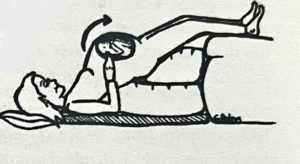What do do if your baby is breech or posterior

A BREECH BABY
Somewhere between 28 and 32 weeks, babies start to turn head first into the pelvic cavity. After 36 weeks, if your baby is still bottom first, then they will be termed ‘breech’. Some obstetricians will suggest that you prepare yourself for a caesarean and more experienced midwives are okay to deliver in breech.
Concerns for safety with a breech delivery include the possibility of compressing or prolapsing the umbilical cord, and the likelihood of the baby inhaling fluid. Other risk factors associated with breech presentation include high rate of death, neurological problems, cerebral palsy, fractures and traumatic conditions such as Erbs palsy.
WHAT CAUSES A BREECH PRESENTATION?
There seems to be a variety of contributing factors for breech presentations; a multiple pregnancy or a history of a premature delivery or breech pregnancy. Other reasons for this inverted presentation may include too little or too much amniotic fluid, an abnormally shaped uterus, growths such as a fibroids or placenta previa.
Most breech babies are born healthy. However, it is important if your caregiver has termed your baby breech that an ultrasound be arranged to assess any risks involved for mother or child. This is also pertinent if you are keen to try any activities which will encourage your baby to move into a more positive birthing position during your last few weeks of gestation.
TYPES OF BREECH PRESENTATIONS
- Frank breech: the baby’s buttocks are aimed toward the birth canal with the legs and feet sticking straight up in front of the body.
- Complete breech: the buttocks are down with the legs folded at the knees and the feet near the buttocks.
- Footling breech: one or both of the baby’s feet are pointing down.
THE CHIROPRACTIC APPROACH TO BREECH BABIES AND OPTIMAL UTERUS TONE
There is no one reason as to why babies move in and out of the optimal birthing position. As the uterus is a “soft tissue”, it stretches with the growth of your baby and often in some directions more than others. The contraction of the uterine smooth muscle is known to be an involuntary action controlled and coordinated by the subconscious brain and nervous system.
Specially trained chiropractors have techniques that we utilise to turn the baby. If you would like to know more you can see the link here: LINK
ACTIVITIES FOR PARENTS TO FOCUS ON:
If an ultrasound has confirmed a breech position (and the baby appears healthy and well), bear in mind there are many different methods that may encourage your baby to turn. So before throwing in the towel along with any hopes you may have had for a vaginal birth, remember that time is on your side. Rather than feeling blue, focus on the following proactive activities:
EXERCISES:
In a breech position your baby is sitting upright in your pelvis, and ideally we wish to encourage him to tip downwards, head first. Angling your body so that your head is lower than your pelvis (so your bottom sticks up in the air) helps to create increased pressure on your baby.
This position encourages him to move crossways and then down into your pelvis, head first. It is also beneficial to Visualize your baby moving into the correct position while you perform these activities.
Knee Chest Position
Arrange yourself on all fours (i.e. on your hands and knees), then lower your upper body so that your head and shoulders rest on the floor, while your bottom remains in the air. Hold for 20 minutes, twice a day.
Breech Tilt
On the floor, in front of your sofa, gather three or four firm cushions or pillows.
Place two of these pillows, one on top of the other, against the base of the couch.
Then place a yoga mat or towel against the base of the couch, adjacent to these pillows. The mat allows for cushioning for your upper body.
The aim of this exercise is to then lie down on your yoga mat and lift your legs onto the sofa. Ensure that your bottom is touching the edge of the sofa. Then lift your pelvis into the air by pushing down with your feet and gently drag the two cushions that are next to you, in and under your legs and bottom. The cushions are meant to support your body at a 45° angle, so you may need to add an extra cushion. This task may sound difficult but with a little persistence and practice, you’ll conquer it.

CONSULT AN ACUPUNCTURIST, HOMEOPATH OR CHINESE HERBALIST
Combining acupuncture and dietary changes to promote an energy balance in the body can help to turn breech babies. Seck a practitioner who has skill and experience in this area. An acupuncturist will aim to realign the electromagnetic energy of the body and may use either acupuncture needles or moxibustion over consecutive sessions.
A Chinese herbalist or naturopath will be able to guide you on specific dietary changes that can promote more yang energy in your body. According to Eastern philosophies, when the body indicates too much ‘yin’ energy, your baby may also adopt this condition and breech positioning will be encouraged. “Yin’ is promoted by too many sugary, cold foods such as ice cream, chemical stimulants such as coffee and smoking, and a lack of rest.
USING SOUND AND LIGHT
Research has shown that babies are able to hear sounds from within the uterus. Some women have had success encouraging their babies to move down towards the birth canal by using headphones playing music held low over the uterus.
Other women use the light of a torch held over the same area to encourage their baby to move down into the pelvis towards the light source. Honestly, I would probably just shine the light source right between my legs directly onto the birth canal so as to avoid any navigational errors or fetal confusion! Take your pick
ELEPHANT WALKING
This posture is designed to encourage your baby out of a breech position. This activity involves walking around the house on your hands and feet (instead of your knees) – this is no easy task.
VISUALIZE
Spend some quiet time visualising babies in the correct fetal position.
DUCK DIVES
Jump in the pool swimming along the surface of the water. Dive and try to go vertically down towards the floor of the swimming pool. Repeat as much as you can.
A POSTERIOR BABY
A ‘posterior baby’ is positioned towards the front of the mother’s body with its spine against her spine. The ideal position for your baby pre-labor is with your baby’s chin tucked under and its spine facing to the front of the mother’s body. With a posterior position, your baby will have difficulty being able to move down and over the cervix. Dilation will be slower and the laboring mother will generally experience significant back pain and a longer labor.
Interestingly, some posterior babies may turn or rotate into a more favorable delivery position during labor itself, particularly with active birth positions.
ACTIVITIES FOR PARENTS TO FOCUS ON:
Beyond chiropractic techniques, the following suggestions can help your baby to move into a more ideal anterior position during your pregnancy.
Specially trained chiropractors with experience in pre and post natal care have techniques to help balance the pelvis and reduce tone in the uterus.
EXERCISES
1. Crawl
Crawl around the carpeted areas of your house in 5-10 minute intervals, 2-3 times a day. You can also rest in this all-fours position and read the paper, for example.
2. Sideways Bend
While in the all fours position keep your upper body still and bring one of your hips up towards the shoulder on the same side. Start by breathing in, then a hip breathe out, tighten the muscles on your left side and draw your hip up towards your left shoulder. As you breathe in, move your hip back to the neu. tral starting position. Repeat on the other side.
3. Back Arching
While in the all-fours position, breathe in, as you breathe out, arch your back upwards and relax your head down. Keep your abdominal muscles relaxed.
Breathe in again and bring your body back to neutral.
With these activities, if you feel your baby move towards the front of your body, so for a walk to encourage the head to engage into your pelvis.
It is recommended that once you know that your baby is correctly positioned ante-riorly (best checked by your midwife), you lie on your left side while resting, which encourages your baby to do the same.
WATCH YOUR POSTURE
Avoid sitting in reclined positions, such as leaning backward on the couch or in car seats. Research suggests that sitting upright in straight-backed chairs, straddling a chair backwards or using office kneeler chairs will encourage your baby to enter the pelvis in an anterior position.
Should you have any questions about the above, please contact us.